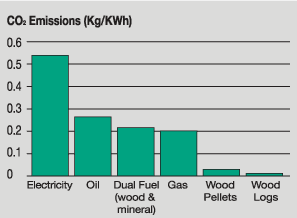 We have talked at length about the environmentally friendly benefits of burning wood. The diagram left, from the SIA (Stove Industry Alliance) shows how environmentally friendly wood logs are in comparison to other fuels.
We have talked at length about the environmentally friendly benefits of burning wood. The diagram left, from the SIA (Stove Industry Alliance) shows how environmentally friendly wood logs are in comparison to other fuels.
The Natural Cycle of Wood:
The natural cycle of planting and harvesting trees has made a sustainable process that will provide carbon neutral fuel for a long time. As we have mentioned in previous articles:
“When managed correctly on a sustainable basis, burning wood maintains a closed carbon cycle, with no net increase in atmospheric CO2 levels. This is in stark contrast to fossil fuels, which do not take any carbon out of the atmosphere but adds lots to it…” – read this full article here
Wood as a Primary Heating Source?
Many people think wood and specifically a wood burning stove can only be used for as a secondary source of heating. However, a wood burning stove can be used as a primary heating source in a home – as a power source for a homes central heating. Currently domestic heating accounts for around 20% of the UK’s carbon emissions, and so you can make a significant reduction to your carbon footprint by switching to wood burning as your primary heating in your home.
How Does a Wood Burning Stove Central Heating Work?
Fundamentally a wood burning stove central heating system works by a water boiler being heated up by the stove, in the same way a regular central heating system would work. The key difference is that with wood you are independent from the grid, know exactly how much wood you are burning, and the resulting cost. The heated water is then circulated around a home to radiators, as it would with a regular heating system.
Although we do not sell stoves that can heat a home via a central heating setup, the fact that burning wood can do this job, is further testament to the fabulous benefits of this solid fuel source we should all become more aware of for a cleaner, greener environment.








